|
F-Class TR Tactical .308
F-TR Champion Brad Sauve's Tough McBros MCRT
Other Guns of the Week >
Continuing our series of interviews with National Champions and World Record holders, this week we feature .308-shooter Brad Sauve, the current U.S. F-TR Class Champion. "TR", standing for "Target Rifle", is a subcategory of F-Class competition, limited to .223- and .308-caliber rifles. At many matches, F-TR competitors are restricted to bipod, ruck or sandbags, though at the Nationals a front rest was allowed. Shooting his rugged, accurate and stone-reliable McBros .308 Winchester MCRT rifle, Brad topped the field at the 2004 Nationals. With his impressive win at Camp Butner, Brad demonstrated that a "tactical" rifle, though built to handle the toughest field conditions, can deliver world-class accuracy.
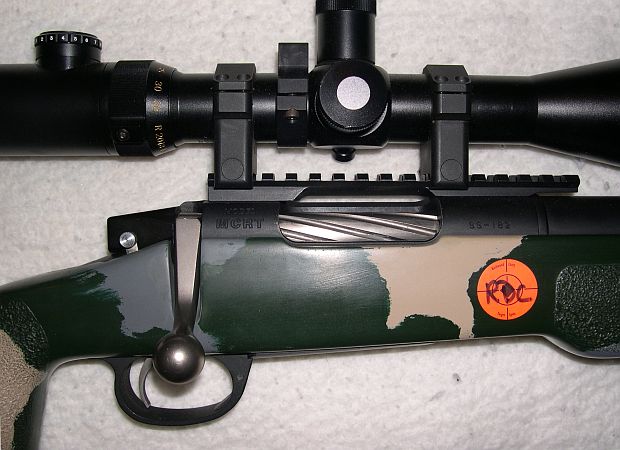
The rifle in the picture carried Brad Sauve to a 2004 U.S. National F-Class win in TR (Target Rifle) Class. It features a McMillan A-2 tactical stock with saddle cheek piece, plus Badger Ordnance rings, bases, trigger guard, and floorplate. The barrel is a Schneider heavy target contour with a 1:11.25" twist, optimized for 175gr Sierra MatchKings. With a 12-42x56 NightForce Benchrest scope on top, the rifle weighs 17 pounds, 15 ounces. Brad tells us, "the unifying theme of all the components would be 'strong and heavy'."
Here is Brad's report on his Nationals-winning rifle: "The McBros (McMillan Brothers) MCRT was my first 'custom' rifle, commissioned six years ago. McBros Rifle Co. built the rifle entirely in their shop. I decided to order a rifle from McBros based on a recommendation from John Droelle, a local fireman and a guy who would give you the shirt off his back, who often said that the difference between his HS Precision rifle and a McMillan is a quarter-minute (i.e., smaller groups). His reference point was his friend, Paul Phillips, who owns a 300 Win Mag MCRT, and regularly amazes onlookers with his rifle's capabilities. Paul knows how to steer the gun, I also must add. I was lucky to be teamed with both of these guys at F-Class Nationals. My rifle took seven months to build, only a month longer than estimated. I found the entire experience of dealing with McBros a professional one. Since then, I've bought two other rifles from this company and I expect to buy at least one more in the near future.
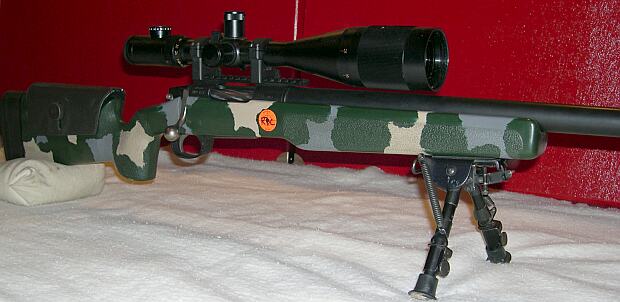
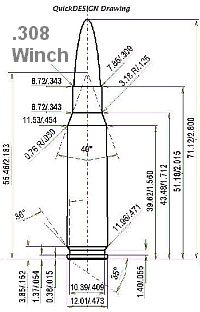 Load Development -- Tried It All, But Slower Was Better Load Development -- Tried It All, But Slower Was Better
I tried A LOT of different loads in the first 600 rounds, starting with 42.0-44.5 N150 for the first 200 rounds, then moving to 44.0-45.0 Varget for the next 300 rounds. I tried different bullets (Sierra 175 MKs both moly and naked, Nosler 180gr Ballistic Tips, 175gr Bergers), different cases (Lapua, Federal), primers (Rem, CCI BR, Fed Match), and, oh yes, seating depths (on the lands to 0.10" off, and several distances in between). Even after 500 rounds of testing, I still wasn't satisfied, and frankly, I was growing weary.
But I finally found my "sweetheart" load on February 14, 2000 (Valentines Day), almost seven months after getting the rifle. This is the load I still shoot today and I shot all weekend at the F-Class Nationals. The break-through came when I discovered that slower velocities produced outstanding accuracy. I found that Varget pushing a 175 SMK at about 2610 fps delivered quarter-MOA groups out to 300 yards and half-minute or better groups beyond that distance. Since developing that load, I've used Lapua cases and Russian primers, but the core elements, 43.0 grains Varget with 175 MKs seated 0.018" off the lands, has not changed.
During the first few years I owned the MCRT, I was crazy about cleaning. My log shows that I cleaned the barrel 80 times in the first 998 rounds. That works out to cleaning every dozen rounds! No wonder it took me so long to find the right load! Boy, have I changed my habits. I still clean the barrel, but I run a much higher round count between cleanings than before. Now, I shoot 100-200 rounds before I give the barrel a thorough cleaning.
| "Spend more time shooting than loading 'perfect' ammunition or cleaning. Squeezing that last ¼ minute out of your groups won't do you any good if you can't hold one MOA or you can't read wind conditions." |
Training -- Learning to Master the .308
I've probably learned the most about shooting by attending the Long Range Firing School (two times so far), where some of the best shooters in the world donate their time to teach others on the basics. When you have individuals like Mid Tompkins, Nancy Tompkins-Gallagher, Emil Praslick and Kent Reeves giving you advice on shooting, reloading and wind-reading and then working with you one-on-one, I can't imagine there is any more effective way to identify and correct defects in your form. I highly recommend this school and the general idea of attending hands-on shooting courses. The cost is minimal, especially considering that by attending one of these courses you can avoid a prolonged period of mediocre shooting results which could very well sap your interest in the sport. I really don't understand why courses like this don't sell out every year. People interested in the Long Range Firing School should contact the NRA Competitive Shooting division. You will see the school listed in the agenda for the National Matches at Camp Perry. The school runs concurrently with the Long Range High-Power events. I believe the NRA offers this course at Camp Perry and at least one other U.S. location.
I've also learned a lot by studying the habits of great shooters by attending matches where these people are shooting and watching what they do in preparing to shoot, how they go about shooting, and how they keep on top of wind changes. Stay behind a world-class shooter once and watch the wind conditions while they shoot. It will soon be clear how these conditions change their pace. I take notes on the smallest details--where they put their hands, where their ammunition and scope are positioned, how quickly they shoot in stable conditions and how they are able to get rounds quickly down range, etc, etc. I've also been blessed to have a few great shooters at my local club whose habits I can watch closely.
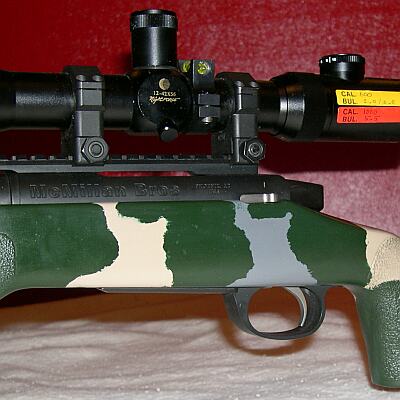 Choosing a Rifle for the Choosing a Rifle for the
F-Class T/R Nationals
In 2003, I started shooting 600-yard scope/sling events with the rifle. That killed my left arm because of the MCRT's heft and because, early on, I didn't know how to properly wear a sling. Since getting a Tubb 2000 rifle in 2003 and concentrating on irons and sling, the MCRT was taken out only occasionally for hunting whitetails and for my daughter to shoot at
F-Class events. In preparing for the F-Class Nationals, I planned to use my Tubb gun ("Teletubby" my friends call it), but I found that the Tubb's stock felt very wobbly on the line. It shot great if you could get it to stay still.
In September, just three weeks before Nationals, I switched to my MCRT, having no doubts that I could compete with it. For practice, I used the MCRT at the Michigan Long Range Championships in Camp Grayling, taking first place in a fairly limited group of F-Class participants with a score of 396-20X, including a first match score of 199-14X. Camp Grayling is notorious for its switching winds and I was pretty happy with the score. If you're near Michigan in the summer, I suggest you attend one of the Michigan Rifle and Pistol Association matches at Camp Grayling. I've often left there with my tail between my legs, but I learned more about wind reading there than anywhere else. Grayling is infamous for its fast switching winds.
When I first saw the announcement of the U.S. F-Class Championship on Long-Range.com, I wanted to go mainly because of the novelty of shooting at the first one, plus I had shot a Palma tournament at Camp Butner earlier that year and was impressed with the range (electric target pullers, wow!). I decided to shoot in Target Rifle class mainly because I thought that my chances were better in this class. I already planned to shoot my .308 Tubb rifle all year, so I thought I'd be able to make wind calls for the .308 by October."
Interview with Brad Sauve
Perspectives on Long-Range Shooting and the Future of F-Class
|
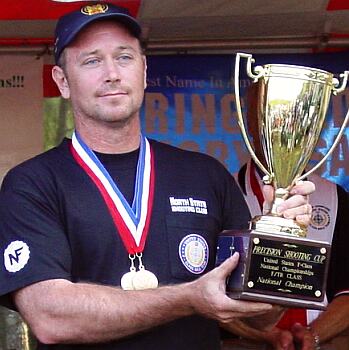 6mmBR.com: We asked Brad, a foreign currency and investment specialist with Dow Corning, how he got involved in competitive shooting. 6mmBR.com: We asked Brad, a foreign currency and investment specialist with Dow Corning, how he got involved in competitive shooting.
I've been shooting since I was a young boy, as I grew up in a rural community where I could spend my afternoons after school and summers shooting blackbirds and starlings with my Daisy BB gun. At age 14, I got my first "real" rifle, a Winchester Model 70 chambered in .270 Winchester. My passion for shooting started in the late 90's in informal bouts with a friend, where we would try to outshoot each other at the local range with our .270's and factory ammo. It wasn't until I first saw someone, who really could shoot, plucking balloons at 600 yards one after another that I realized that there was another world of shooting (and accuracy) about which I knew very little. That inspired me.
My first competitive match was in August 2002 at the F-Class Championships at the Connaught Ranges in Ottawa, Canada. There, I shot at distances I had never shot at before, from 700 to 900 meters. I shot an Accuracy International chambered in 7x61 Sharpe & Hart and it shot very well. The problem was that I knew nothing about shooting in the wind. Despite it all, I was happy with my performance. I remember that I finished a few points higher than Leslie Crone, which I thought was notable. In 2003, I started shooting service rifle at 600 yards, purchased my Tubb 2000 rifle, shot the 600-yard matches at Nationals at Camp Perry, and attended the Long Range Firing School. In 2004, I started to have more success at local High-Power matches, acquired my Long Range High Master card, shot in all of the long-range High-Power matches at Nationals, and attended the Long Range Firing School a second time. My plan this year is to continue to focus on shooting the .308 Win with sling/irons working towards a specific goal at the end of this season. I think everyone needs to sets individual goals and work towards them.
Q: What is your advice for beginners, particularly those just starting out in F-Class?
First and foremost--shoot more! You should spend more time shooting than you spend reloading and cleaning. Spending time squeezing that last quarter-minute out of your groups with obsessive reloading procedures won't do you any good if you can't hold one minute of angle or you can't read a change in wind conditions. If a range facility is not convenient, shoot in your basement with a pellet gun. If the range nearby has only 100 yard targets, practice wind reading skills by shooting a .22LR. Go as often as you can and always try to learn something each time you practice.
I've found people in the shooting community to be very open and willing to help new shooters. Be willing to ask stupid questions, but be respectful and mindful of the fact that shooters also need some "alone time" particularly before a match. Go with realistic expectations and goals, observe others while you are not shooting and take notes.
Q: Do you have any tips for people transitioning from .223 to the heavier-recoiling .308?
As for transitioning, when I went from an AR-15 to a .308, I didn't really have a problem as my rifles have always been on the heavy side and I often wear a thick sweatshirt (and leather coat for sling work) when shooting. If you are noticing recoil, it is affecting your shooting. Either add weight to your rifle or buy recoil pads to eliminate this distraction.
Q: How about equipment? What does one need to be competitive?
Invest in an accurate rifle. New, used, doesn't matter as long as it out shoots you. Invest in a scope that you can trust when you make adjustments. There is nothing more frustrating than doing everything to near perfection and having your equipment fail you. How do you know how you're doing and what changes to make to improve if your equipment is faulty? If you're not sure about your rifle's capabilities, give it to a good shooter and let them shoot it. This is a quick way to see if it is the rifle or the guy/gal behind it.
Q: What's the role of the spotter in your matches. How closely do you work as a team? Who ultimately makes the wind calls?
One teammate may watch the trace if the shooter does not have a good zero and needs to get on target, but otherwise our team functions where one person (the coach) makes all wind calls and the shooter's job is to execute the coach's orders and call their shot afterwards; that it. That is the only way the coach is going to determine their next call. If you question the coach's call because you believe you see something they might have missed, let the coach know before you shoot and get their agreement. Don't disregard the call and hold where you think you should. If you're doing that, why do you have a coach?
Q: Tell us about your shooting position, and how you position bipod and bag.
In F-Class, when I set the rifle up on the line, I set the bipod as short as possible (6"), then plant the 'pod's legs firmly in the ground in front of my shooting mat. I've learned that I do not want the legs on the mat--they could slip when I lean into the rifle (note the skid marks in the photo below). I check the bubble on my scope to ensure the rifle is level. I plant the buttstock firmly against my shoulder and, with my left hand, I push my small canvas bag (filled with plastic pellets) as far back under the buttstock as possible.
Starting from my jaw, I lay my cheekbone squarely down on the cheekpiece. I lay on the cheekpiece like I'm laying on a pillow. I relax my body and check my sight alignment with the eyepiece of the scope. I wear a shooting cap that shades my eyes and allows me to focus on what's in front of me rather than on peripheral distractions. I wear earplugs AND earphones to block as much noise out as possible.
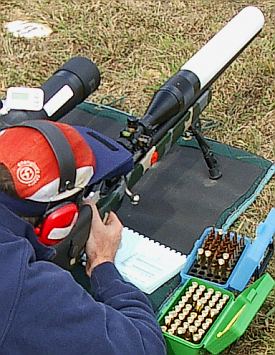 Q: What is your approach to gun-handling? Do you have any special practice techniques for steering the rifle? Q: What is your approach to gun-handling? Do you have any special practice techniques for steering the rifle?
I like stable platforms and to get stability I shoot as low a profile as I can. When shooting F-Class, I don't raise the legs of the bipod unless I have to level out the rifle or if the place I'm laying is not level. Dry fire your rifle with your scope up at its highest power to see if the pressures you are putting on your gun are pushing it off your aiming point. How you pull the trigger, where you place your thumb, how your buttstock is placed in your shoulder will all affect your follow-through. Better yet, have a friend load your rifle by alternating live and dummy rounds and check your trigger control and follow-through. If you rifle moves when you pull the trigger with the dummy round, you need to work on your control and follow-through.
Q: Do you have any special reloading methods that have given you a noticeable improvement in accuracy. (E.g. David Tubb uses a Prometheus measure, and James Phillips neck-turns each case three times.)
I haven't changed my reloading methods in quite a while. The last change I've made is moving back to a beam scale to check the powder my Harrell's measure is throwing. I've moved away from electronic scales as my new reloading room is full of fluorescent lights, which gives these scales fits. For a major match, I sort bullets according to weight in 0.1 grain increments. I check the necks, and if there is a great deal of variation, I will neck turn but grudgingly so. My cases are sorted by weight and usually a lot of 100 cases will weigh the same +/- 0.2 grains. I did switch to Russian primers because they cost less and because they've produced impressively low SDs for me. Though many people don't clean primer pockets, I still do unless I wet-tumble (then the stainless steel bits clean the pockets for me). I wet-tumble now to get the inside of the cases clean.
I admit that I don't go to the lengths that some others do in preparing their loads, but then again I'm not trying for a world-record group. I just want an X or 10, and I believe I can get a greater improvement in my scores by shooting more rather than prolonging my time in my reloading room. If I make it to retirement and have more time on my hands, I'll consider additional measurements in the process of making ammunition, but with a wife, four children, and a full-time job, when I have time I would rather shoot than spend the day fussing with brass.
Q: What Changes would you like to see in F-Class in the months/years ahead. What can be done to keep both the Open Classers and the F-TR competitors happy? Do we need to revamp any of the rules?
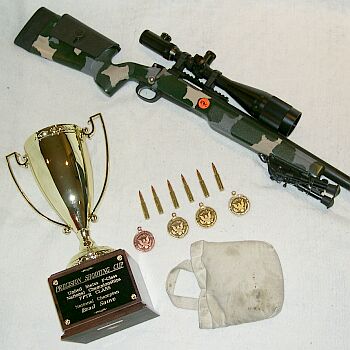 Keep the rules as simple and as open as possible since F-Class is just getting started. If you adopt highly restrictive rules to meet the desires of the "purists", you will never grow the sport. Creating shooter classifications will enable shooters to compete with others at their level. I don't mind restricting F-TR to bipod only, as most everyone has a bipod, but when you start imposing tough new restrictions, you will not get the shooter turn-out that F-Class needs. We need to build attendance not only at the national level, but also at the regional, state, and local levels. Draft the rules so that both the man with a capable hunting rifle and the shooter with a custom Palma rifle can play together. I won the National F-TR Championship with a a mag-fed rifle with a 26" barrel, bipod and cheap canvas rear bag, competing against shooters with 30" barrels, single-shot actions, and benchrest bags. I favor as few restrictions as possible. Keep the rules as simple and as open as possible since F-Class is just getting started. If you adopt highly restrictive rules to meet the desires of the "purists", you will never grow the sport. Creating shooter classifications will enable shooters to compete with others at their level. I don't mind restricting F-TR to bipod only, as most everyone has a bipod, but when you start imposing tough new restrictions, you will not get the shooter turn-out that F-Class needs. We need to build attendance not only at the national level, but also at the regional, state, and local levels. Draft the rules so that both the man with a capable hunting rifle and the shooter with a custom Palma rifle can play together. I won the National F-TR Championship with a a mag-fed rifle with a 26" barrel, bipod and cheap canvas rear bag, competing against shooters with 30" barrels, single-shot actions, and benchrest bags. I favor as few restrictions as possible.
Q: Would you like to see F-TR opened up to calibers other than .223 and .308, or then does it just essentially become "Open" with bipod?
I do think that there is a definite advantage in using rifles that can propel ultra-high BC bullets at very high velocities so I believe it's fair to limit F-TR to the .308 or .223. You could set a restriction using velocity or BC limits, but the caliber restriction is probably easier to enforce. Rifles which do not meet F-TR requirements should shoot in F-Open. For example, I think the person who shoots a tactical rifle chambered for 300 Win Mag or 338 Lapua, and can shoot it well, can be competitive in F-Open, even if they are using a bipod.
Q: Do you think there should be a "factory" class or perhaps a tightly controlled one-design class. The goal would be to keep entry costs down and provide one division where everyone shoots the same, affordable equipment. This would be similar to Service Rifle Class in High-Power competition, but perhaps with even tighter rules--maybe only one manufacturer for example.
I like the idea of adding classes if you can improve attendance. Add too many classes early on and you end up with not enough shooters in one class to justify awards or enable those who win to feel like they won anything of merit. The problem with classes though is definition. What constitutes a "factory" gun? Would that include an Accuracy International rifle, a Tubb 2000 rifle, a Knight SR-25, a Remington or Winchester Custom Shop rifle? How about a Remington Model 700 with a trued action, lapped barrel, polished chamber, and action bedded by Iron Brigade Armory? If it improves attendance, I'm all for it.
Q: You shoot both High-Power and F-Class matches and have done very well at both. Maybe you could explain a little about the difference in courses of fire and whether you need to employ different strategies or shooting styles in a High-Power vs. F-class.
The two styles of shooting I enjoy are long range High-Power shooting (including Palma), and F-Class shooting. In long range High-Power and Palma, you shoot at distances between 600-1000 yards using slings and typically iron sights. As you are fully supporting the rifle with your body, your ability to find a stable position is more critical than in F-Class shooting. Since you typically shoot with iron sights, good eyesight (or corrected eyesight in my case) is also critical, whereas in F-Class the scope can be your corrective lens. In F-Class it is easier to stay on top of wind conditions, since you can always see evidence of these conditions through your scope. In High-Power, you can only focus on one thing at a time--your spotting scope or your iron sights--so you need more skill in judging where the wind is in its cycle. Experience in High-Power will make you a good F-Class shooter, while the same cannot be said for the transition from F-Class to High-Power due to the factors I've identified above. I'd like to add that while I shoot a tactical-style rifle at F-Class matches, I do not shoot what I consider tactical matches ("pressure" scenarios and targets at unknown distances) though I would love to try this sometime.
2004 U.S. F-Class Championship -- Report from the Firing Line
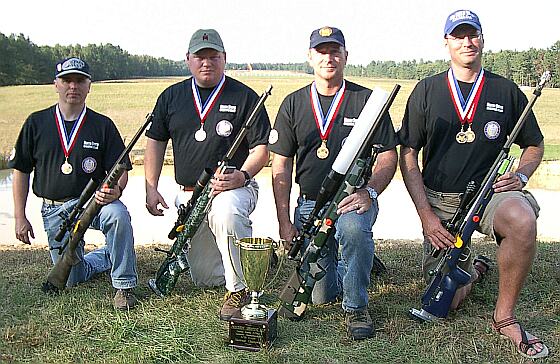
The 'Great Lakes Express' F-TR Team (left to right): John Droelle, Paul Phillips, Brad Sauve, and Ray Gross
The 'Great Lakes Express' -- First Place U.S. F-Class Nationals TR Team
Only a couple of months before October, Paul Phillips recruited Ray Gross and John Droelle to join him at Butner and invited me to be part of their Target Rifle team, which he dubbed the "Great Lakes Express". It is odd to think I was the elder team member, as all of these guys had more years of competition under their belt and each had already done well at National events. Ray was our most famous shooter, as a member of the 2003 US Palma team and holder of several National trophies. Ray was an iron/sling man and it took some convincing to get him behind a rifle with a scope and a rest, but he was a vital element of our team as a shooting member, coach and wind-reader. Paul is adept at handling anything that can possibly hurt you and his competitive nature is contagious. In a prior life, Paul probably was the one who killed the last of the dinosaurs with sharp sticks. John was a winner in his class the first time he shot in the Long-Range Nationals at Camp Perry.
The Express Rolls -- 850 Miles of White Line Fever -- Making Weight by a Nat's Ass
We arrived at Camp Butner on Thursday after driving all night from Michigan, about 850 miles. I think I slept the night before, but am not so sure if it was an hour or two. Nevertheless, the bright sun in North Carolina waked me up somewhat (walking zombie). I had my rifle weighed, which prior to this time I had only done with a bathroom scale. On a official scale, the rifle weighed 17.93 pounds--eerily close to the 18.15-pound Target Rifle limit. I did not plan to be this close! Later that day, we got a chance to fire some shots to check our zeros. I shot seven shots at 1000 yards, finding that my elevation zero was one MOA lower at Butner than back home, and called it a day. I can't remember much after that--I fell asleep soon after hitting the bed while the other (young) guys made for the local taverns.
Day One – 600 yards -- Man Those Targets are Small, but Team Takes First
Game day. How exciting. The familiar faces of famous shooters, and the warm sun of North Carolina! Hunting or shooting with fellows who enjoy same, there aren't too many other things that warm my spirit much more in life. The agenda for the day was three 15-round matches and one 15-round team match at 600 yards. I drew a different target than my teammates (since I submitted my forms some months before they did), but my relay shot first so I was happy. I had never shot on the SR-3 target before at 600 yards, which had a 3" X-ring but I figured that the 7" 10-ring was achievable and just hoped that my shots would cluster somewhere near the center of that space. I remember that winds were light and readable, so I expected scores would be high. I dropped more shots than I thought, going outside the 7" ring eleven times that day. To make myself feel better, I figure that if I shot quarter-minute groups at 600, my shots might vary as much as 0.75" from center. That, and a one-mph wind miscalculation would push me almost 4" from center and into the 9-ring. The same miscalculation with my 6.5-284 and I would still be 0.75" within the 10-ring. Oh well--I ended up Third for the day, two points behind First place. I was happy with my X count – only three of us in Target Rifle class had 15 X's, Kurt Hester (who held First place) and Anthony Cockerham. As a team, we shot well taking first place for the day in Target Rifle class, 11 points ahead of the next best team.
Day Two -- Bigger Targets at 1K. With 23 Xs I move into Second Place
The second day we had three 1000-yard individual matches and one team match. The wind gods were still unbelievably gentle and my relay shot second in the morning--life is good! That one-minute X-ring at 1000 yards was very nice to see, after contending with half as much the day before. Scores improved as a result with Kurt Hester beating everyone again, dropping only 1 point in the second match and placing 27 of his 45 record shots in the X-ring. I hung in there, placing 4th that day, dropping only 2 points (coincidently, in the second match as well) and ringing the X bell 23 times. Kurt was stretching his lead at this point, up 7 points on me for the first two days, but I was still excited at being Second overall and excited about the possibility of being one of the top 10 to receive medals, IF I could keep everything together in the final two 1000-yard matches on Sunday.
After two days of mild winds, I just knew my luck was going to run out soon. Stronger winds were predicted for Sunday and I was starting to feel the heat from my team-mates who were closing in quickly behind me. Ray and Paul finished Second and Fifth, respectively, on Day Two. They both started looking like big bad wolves to me, licking their chops at the thought of shooting in stronger winds where they knew they could slaughter the little pigs. Luckily, these wolves were on my team, and we extended our team lead even further on Day Two by another 14 points, dropping only three points overall and putting 36 of our 60 shots in the X-ring. Our team (all shooting .308s) actually tied (on Day Two) the overall winner of F-Class Open--the team of John Brewer, Bob Crone, Shawn Ahrens, Walter Stroman, with Emil Praslick as dedicated wind coach. We smoked that team TR event on Saturday!!
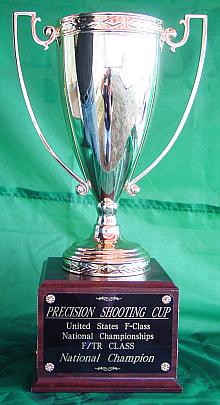 Day Three -- Winds Arrive -- But Patience Pays Off Day Three -- Winds Arrive -- But Patience Pays Off
Well, it finally had to happen. Three consecutive days of gentle breezes at Butner did not make any sense. Day Three's program included two 1000-yard individual matches to close out the individual competition and one last team match. Unfortunately, it was finally my relay's turn to shoot third. My teammates, Ray and Paul, shot in the first two relays in calmer winds. Ray certainly took advantage of it, shooting a scorching 150-10X, the top score for the first match that day. Paul was second with a 150-9X, tied with Carlos Macaraeg. My 148-8X put me in the top 10 for the first match--not bad given the worsening conditions. Kurt Hester also shot in my relay and scored 149-6X, still six points above me in the Aggregate. Frankly, I did not expect to catch Kurt with one match left. My goal was to shoot as best as I could and hopefully hang on to Second place.
In the last individual match, I took a lot of sighters plotting the effects of the pick-ups and let-offs to see what I might have to deal with during my shots for record. While shooting for record, I shot as fast as I could as long as the mirage and flags both indicated the prevailing wind con-dition was holding. If the prevailing condition was not there, I waited it out, watching the countdown timer to make sure that I would not fall short on time. With just over half of my record shots over, I remember the winds changing at which point I sat on my rifle for what seemed like eternity, probably close to seven minutes. Fortunately, with time still to spare, the prevailing condition returned and I shot like a madman to get the rest of my record shots off in that condition. I have to say, the key factor allowing me to do well in this last match was patience in staying off the gun for those seven minutes. Winds for the last match were at their worst, yet I managed to shoot a 147-9X, only second to David Huskin's uncanny 150-10X (wow!) in the last match. My score in that last match put me in First place in the Aggregate. Ray finished Second while Paul ended up Third in F-TR.
Winds did not let up for the team match. Ray did a great job calling the wind. Ray determined our prevailing wind zero in our two allowed sighters, and told us exactly where to hold ("3 o'clock, mid-ring 10") on the target. Our job was to repeat back to him the target number we were shooting before every shot (to ensure no rounds went on the wrong target), to execute exactly his instructions, and to tell him our shot-call after each shot. That way if we felt we pulled the shot in a certain direction, he could filter out our mistakes in making the wind call for our next shot. The "Great Lakes Express" team gained another 21 points on the next closest team and finished the tournament with 1842 points, 46 points ahead of the next closest F-TR team and with more points than over half of the F-Open teams.
Report by Brad Sauve |
Did You Enjoy Reading this Article? If So, You Can Help Support
6mmBR.com by Making a Small, Secure Contribution.
Copyright © 2005, 6mmBR.com, All Rights Reserved. No reproduction of any content without advanced permission in writing.
Topics: F-Class, McMillan, McBros, F-TR, F T/R, .308, 7.62x51, Tactical, Target Rifle, Palma, 600yd, 600 yards, Score, Group, Agg, Aggregate, Benchrest, .223, AR15, Tubb 2000, 6mm, 6mm BR, 6BR, Sling, Iron Sights, 6mm Improved, Light Gun, 6PPC, Hart, Krieger, 1000 yards, Camp Butner, NightForce scope, 12-42x, Jewell, Benchrest, BR, Bench Rest, magazine, competition, rifle accuracy, Wind, BC, Ballistics, Norma, Hodgdon Powder, Varget, 4895, H4895, RL15, Reloader, Vihtavuori, Sierra, MatchKing, Competition Shooting, Stocks, Badger Ordnance, Badger Rings, stainless barrel, reloading, powder, case forming, neck-turning, Lapua Brass, bullets, precision, NC, North Carolina.


|